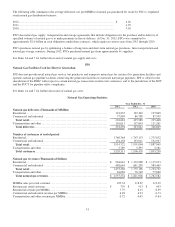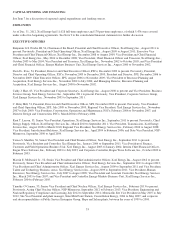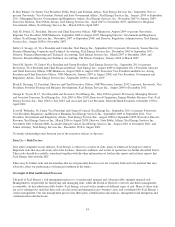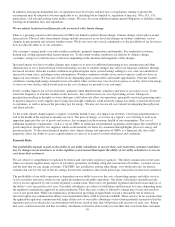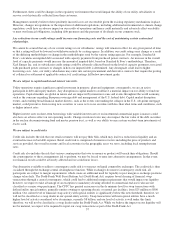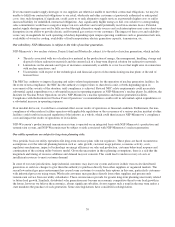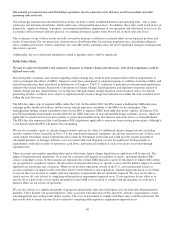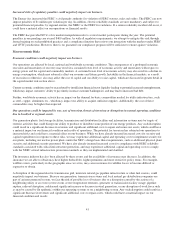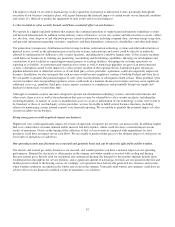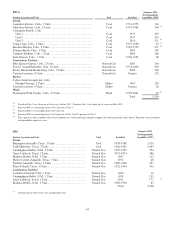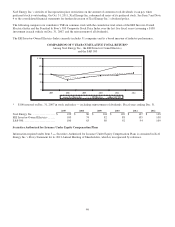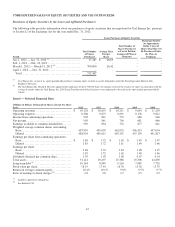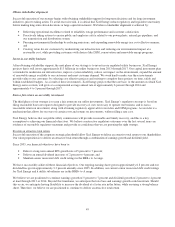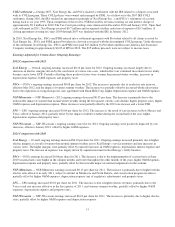Xcel Energy 2012 Annual Report Download - page 51
Download and view the complete annual report
Please find page 51 of the 2012 Xcel Energy annual report below. You can navigate through the pages in the report by either clicking on the pages listed below, or by using the keyword search tool below to find specific information within the annual report.41
Increased risks of regulatory penalties could negatively impact our business.
The Energy Act increased the FERC’s civil penalty authority for violation of FERC statutes, rules and orders. The FERC can now
impose penalties of $1 million per violation per day. In addition, electric reliability standards are now mandatory and subject to
potential financial penalties by regional entities, the NERC or the FERC for violations. If a serious reliability incident did occur, it
could have a material effect on our operations or financial results.
The FERC has provided NOVs of its market manipulation rules to several market participants during the year. The potential
penalties in one pending case exceed $400 million. As with all regulatory requirements, we attempt to mitigate this risk through
formal training on such prohibited practices and a compliance function that reviews our interaction with the markets under FERC
and CFTC jurisdictions. However, there is no guarantee our compliance program will be sufficient to ensure against violations.
Macroeconomic Risks
Economic conditions could negatively impact our business.
Our operations are affected by local, national and worldwide economic conditions. The consequences of a prolonged economic
recession and uncertainty of recovery may result in a sustained lower level of economic activity and uncertainty with respect to
energy prices and the capital and commodity markets. A sustained lower level of economic activity may also result in a decline in
energy consumption, which may adversely affect our revenues and future growth. Instability in the financial markets, as a result
of recession or otherwise, also may affect the cost of capital and our ability to raise capital, which are discussed in greater detail in
the capital market risk section above.
Current economic conditions may be exacerbated by insufficient financial sector liquidity leading to potential increased unemployment,
which may impact customers’ ability to pay timely, increase customer bankruptcies, and may lead to increased bad debt.
Further, worldwide economic activity has an impact on the demand for basic commodities needed for utility infrastructure, such
as steel, copper, aluminum, etc., which may impact our ability to acquire sufficient supplies. Additionally, the cost of those
commodities may be higher than expected.
Our operations could be impacted by war, acts of terrorism, threats of terrorism or disruptions in normal operating conditions
due to localized or regional events.
Our generation plants, fuel storage facilities, transmission and distribution facilities and information systems may be targets of
terrorist activities that could disrupt our ability to produce or distribute some portion of our energy products. Any such disruption
could result in a significant decrease in revenues and significant additional costs to repair and insure our assets, which could have
a material impact on our financial condition and results of operations. The potential for terrorism has subjected our operations to
increased risks and could have a material effect on our business. While we have already incurred increased costs for security and
capital expenditures in response to these risks, we may experience additional capital and operating costs to implement security for
our plants, including our nuclear power plants under the NRC’s design basis threat requirements, such as additional physical plant
security and additional security personnel. We have also already incurred increased costs for compliance with NERC reliability
standards associated with critical infrastructure protection, and may experience additional capital and operating costs to comply
with the NERC critical infrastructure protection standards as they are implemented and clarified.
The insurance industry has also been affected by these events and the availability of insurance may decrease. In addition, the
insurance we are able to obtain may have higher deductibles, higher premiums and more restrictive policy terms. For example,
wildfire events, particularly in the geographic areas we serve, may cause insurance for wildfire losses to become difficult or
expensive to obtain.
A disruption of the regional electric transmission grid, interstate natural gas pipeline infrastructure or other fuel sources, could
negatively impact our business. Because our generation, transmission systems and local natural gas distribution companies are
part of an interconnected system, we face the risk of possible loss of business due to a disruption caused by the actions of a
neighboring utility or an event (severe storm, severe temperature extremes, generator or transmission facility outage, pipeline
rupture, railroad disruption, sudden and significant increase or decrease in wind generation, or any disruption of work force such
as may be caused by flu epidemic) within our operating systems or on a neighboring system. Any such disruption could result in a
significant decrease in revenues and significant additional costs to repair assets, which could have a material impact on our
financial condition and results.


